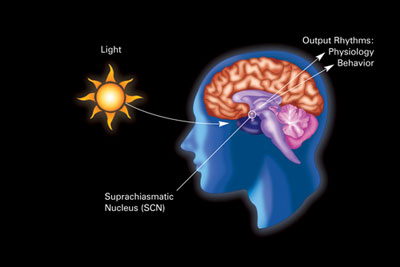To make this clear, my idea came before I research any existing products in the market, but only to realise how similar my idea is to this lamp from Philips. It's the Wake-Up Light
Wake-Up light is doing quite the same as my idea, it has the feature of simulating sunset to compensate the effects done by artificial light at night. Although I am not sure if circadian rhythm can be adjusted by this mean, the light was designed in this regard. When a certain function is turned on, the lamp will slowly dims down over 30 minutes duration.
In the morning, the lamp also simulates the sunrise by gradually brighten the light and the colour changing according the the actual sunrise, along with various default nature sounds to wake up the person (you can supposedly choose any music in your music library, I am not an expert but I highly doubt that waking up with heavy metal is anywhere close to natural)
It also can track your sleeping quality and pattern, but the accuracy should be under review, there are two common way to track sleep, I have explained this in the previous post. In this product, I think (but not sure), it is using the accelerometer inside your phone to track the your movement during your sleep. However, the mobile phone in this case, is on a docking station not on the bed, very unlikely to detect any movement that is occurred on the mattress, but this is one of the key feature to the mobile app Philips has provided.
So the question now is, how do I differentiate this Philips Wake-Up light from my own idea, I think there is some similarity between the two, but the main focus of the two are not the same. Wake-Up light is not designed to change a person's behaviour but to suit their lifestyle.
The product allows the user to customize many features. But to me and my idea, I mainly wish to change the people's behaviour. The sunsets simulation is identical to my idea when the light dims and head droops, but the simulation from Philips starts when the phone is docking on the station in the evening, this will only happen when the person is ready to sleep. My project on the other hand, is for reminding people who has NOT yet gone to sleep. You see the difference? One is purely suiting the user, the other is changing the user, and this links back to my thesis where Marc Hassenzahl stated that "convenience will not instill change but friction will."
So the question now is, how do I differentiate this Philips Wake-Up light from my own idea, I think there is some similarity between the two, but the main focus of the two are not the same. Wake-Up light is not designed to change a person's behaviour but to suit their lifestyle.
The product allows the user to customize many features. But to me and my idea, I mainly wish to change the people's behaviour. The sunsets simulation is identical to my idea when the light dims and head droops, but the simulation from Philips starts when the phone is docking on the station in the evening, this will only happen when the person is ready to sleep. My project on the other hand, is for reminding people who has NOT yet gone to sleep. You see the difference? One is purely suiting the user, the other is changing the user, and this links back to my thesis where Marc Hassenzahl stated that "convenience will not instill change but friction will."



















